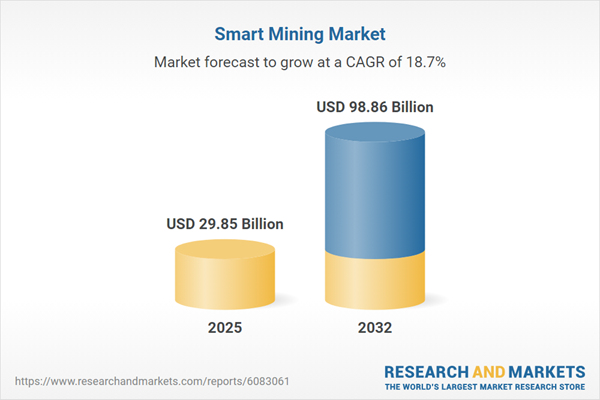Speak directly to the analyst to clarify any post sales queries you may have.
The Smart Mining Market is advancing digital transformation within the global mining industry, driving modernization across operational processes and safety protocols. For senior leaders, the transition to integrated digital solutions represents a pivotal opportunity to build more resilient and sustainable mining operations equipped for future challenges.
Market Snapshot: Smart Mining Market Size and Growth Outlook
The Smart Mining Market is expanding rapidly, with its value set to grow from USD 25.10 billion in 2024 to USD 29.85 billion in 2025, and forecasted to reach USD 98.86 billion by 2032 at a CAGR of 18.69%. This strong momentum is linked to several industry-wide shifts: mining organizations are bolstering investment in digital mining technologies to address updated safety regulations, achieve sustainability mandates, and adapt to evolving competition. These conditions are redefining strategic priorities in both mature and fast-developing mining sectors globally.
Scope & Segmentation: Smart Mining Market
- Component: The market includes hardware—such as advanced drilling systems, heavy machinery, and personnel safety equipment—along with essential services like consulting, maintenance support, and integration, as well as software for fleet management, predictive maintenance, and digital resource planning.
- Mining Type: Applications span both surface and underground mining, each requiring tailored technology and compliance solutions matched to unique safety and productivity needs.
- Application: Major segments are coal mining (covering both coking and thermal types), metal mining (focusing on copper, gold, iron ore), and mineral mining (including diamonds and phosphate), each driving demand for specific extraction automation and adherence to stringent compliance standards.
- End User: The market serves large-scale mining operators alongside small and mid-sized enterprises, each group differing in the maturity of digital transformation, operational scale, and adoption strategies for advanced technology.
- Deployment Model: The sector supports cloud-based infrastructures, which enable remote monitoring and scalability, as well as on-premises architectures valued for data security and operational reliability in remote or sensitive regions.
- Geography: Demand is distributed across the Americas (highlighting markets such as the United States, Canada, Brazil, Mexico, Argentina, Chile, Colombia, Peru), Europe, Middle East and Africa (including the United Kingdom, Germany, France, UAE, South Africa), and the Asia-Pacific region (with countries like China, India, Australia, Japan, South Korea, and Indonesia).
- Companies Covered: Leading industry participants include Cisco Systems, IBM, Siemens, ABB, Hexagon, Dassault Systèmes, Hitachi, Komatsu, Caterpillar, and Epiroc, each shaping technology standards and steering innovation agendas that address global mining challenges.
Key Takeaways for Senior Leaders
- Integrated digital platforms unifying hardware telemetry, advanced analytics, and mine planning software are enabling safer and more streamlined operations.
- Automation technologies, such as autonomous haulage and predictive maintenance, are minimizing equipment downtime while supporting optimized resource extraction and site productivity.
- Cloud-based systems are facilitating seamless remote management for globally distributed teams, while on-premises deployments address critical regulatory and data governance requirements in sensitive environments.
- Investments in simulation-based training and workforce upskilling are helping mining companies close capability gaps as digital competencies become essential for operational sustainability.
- Resilient supply chain strategies are increasingly important, promoting flexible procurement and diversified supplier relationships to ensure continuity amid regulatory shifts and market disruptions.
- Collaboration with OEMs, technology integrators, and research organizations is accelerating technology adoption and enhancing the mining sector's ability to adapt during periods of market and regulatory change.
Tariff Impact on Equipment and Supply Chain Strategy
Recent changes in US tariffs affecting mining equipment and select mineral commodities have prompted mining organizations and equipment manufacturers to reassess procurement and contracting strategies. Operators increasingly source equipment from regional suppliers and strengthen local maintenance partnerships to control operating costs and reduce risk. Enhanced cooperation with technology vendors and original equipment manufacturers ensures greater asset uptime, meeting the industry’s need for consistent supply chain performance despite ongoing regulatory shifts.
Research Methodology & Data Sources
This report is based on a robust mixed-methodology approach: comprehensive secondary research is combined with detailed interviews of industry leaders, operations personnel, and subject matter experts. Rigorous data validation layers draw from public disclosures and in-market intelligence to provide precise findings tailored to current industry realities and smart mining market trends.
Why This Report Matters for Decision-Makers
- Supports strategic planning and informed investment decisions as the digitalization of mining continues to transform operating models and competition.
- Offers actionable segmentation analysis and region-specific recommendations, guiding successful technology adoption in diverse global markets.
- Arms leadership teams with a data-driven blueprint to anticipate regulatory, compliance, and workforce adaptation needs for sustainable operations.
Conclusion
Effective use of market intelligence empowers mining leaders to implement safer, more efficient, and environmentally responsible operations. Adapting strategy with technology alignment and workforce capability ensures long-term resilience and competitiveness in the evolving mining industry.
Table of Contents
3. Executive Summary
4. Market Overview
7. Cumulative Impact of Artificial Intelligence 2025
Companies Mentioned
The companies profiled in this Smart Mining market report include:- Cisco Systems, Inc.
- International Business Machines Corporation
- Siemens Aktiengesellschaft
- ABB Ltd
- Hexagon AB
- Dassault Systèmes SE
- Hitachi, Ltd.
- Komatsu Ltd.
- Caterpillar Inc.
- Epiroc AB
Table Information
| Report Attribute | Details |
|---|---|
| No. of Pages | 182 |
| Published | November 2025 |
| Forecast Period | 2025 - 2032 |
| Estimated Market Value ( USD | $ 29.85 Billion |
| Forecasted Market Value ( USD | $ 98.86 Billion |
| Compound Annual Growth Rate | 18.6% |
| Regions Covered | Global |
| No. of Companies Mentioned | 11 |









